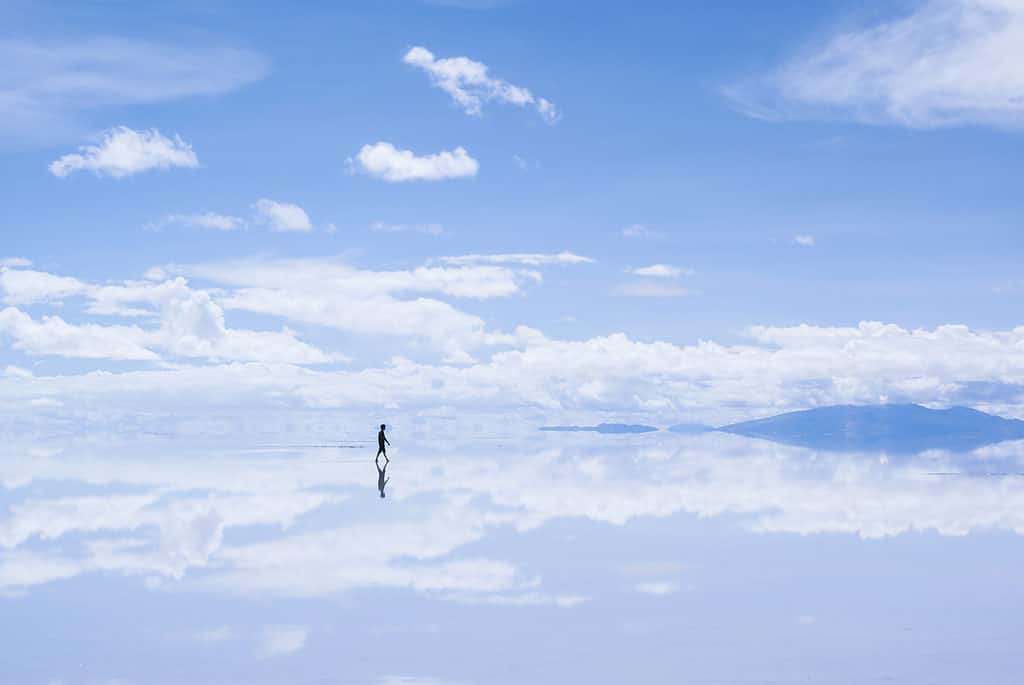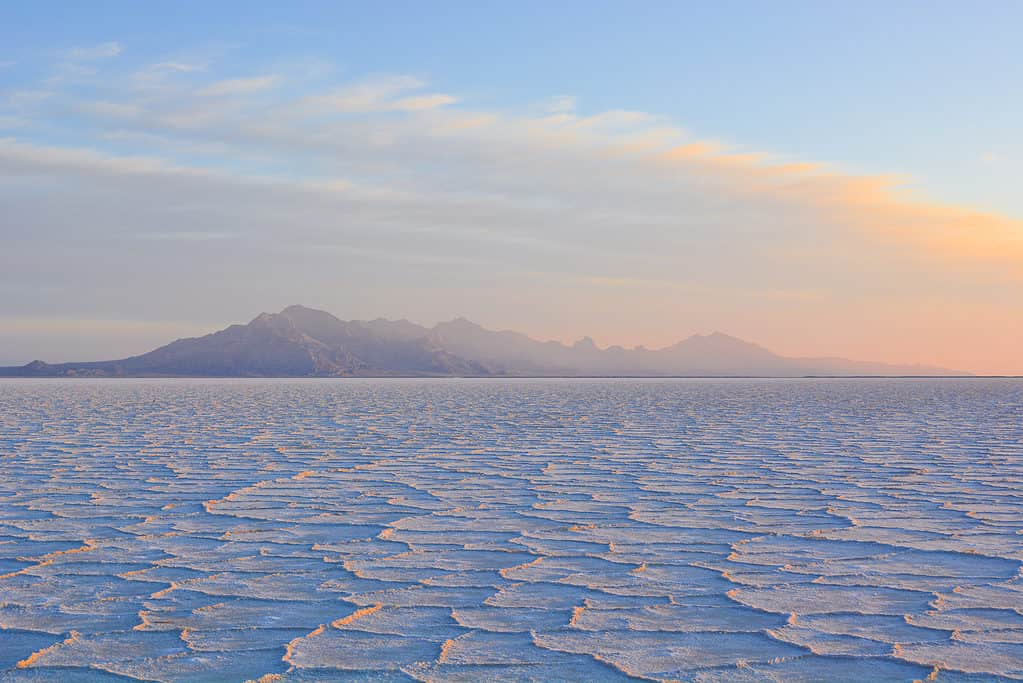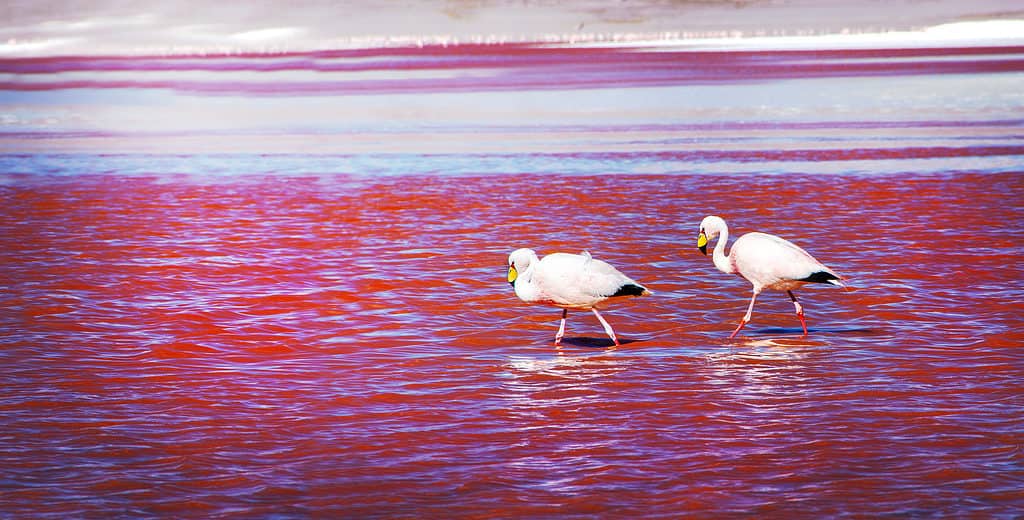The world is home to a lot of unique biomes, some that defy the imagination. Among the strangest naturally occurring features of the earth is a region known as a salt flat. Salt flats, sometimes known as salt pans, are huge expanses of flat ground that are primarily covered in salt and other similar minerals, giving them a unique appearance. Today, we are going to discover the largest salt flat in the world, plus learn a little more about them. Let’s get started!
The Largest Salt Flat in the World

Salar de Uyuni is the largest slat flat in the world.
©iStock.com/shinnji
Salar de Uyuni, located in Bolivia, is the largest salt flat in the world. Spanning over 4,050 square miles of the Altiplano, it is a unique and extreme landscape left behind by prehistoric lakes that evaporated a very long time ago, leaving behind only the minerals.
The salt flat is characterized by a thick crust of salt that extends to the horizon, creating a quilt-like pattern of polygonal shapes (imagine cracking mud, just white and thin). At certain times of the year, nearby lakes overflow and dump water on the salt, creating a natural mirror that shows a beautiful reflection of the sky.
The salt flat itself serves as a natural resource for extracting salt and lithium, one of the most important ingredients for most batteries used in handheld electronics today. Salar de Uyuni is a renowned tourist destination, home to the world’s first salt hotel, and is located at the intersection of Bolivia, Chile, and Argentina.
The Largest Salt Flat in the United States

The Booneville Salt Flats were once home to a massive lake.
©iStock.com/Akshay Patel
The Great Salt Lake Desert is the largest salt flat in the United States, although it isn’t continuous, keeping it from being the largest overall. It is located in the Western United States, primarily in Utah and partially in Nevada.
The desert covers an area of about 7,000 square miles, and it is known for its vast expanses of salt flats and barren landscapes, the most famous of which are probably the Bonneville Salt Flats. The lake that once took up the area was truly massive, making up a surface area equivalent to that of modern-day Lake Michigan.
The Great Salt Lake Desert is an important region for mining and extracting salt, potash, and other minerals, and the mining industry has been a significant economic driver for the region for many years. The area is also used for recreational activities such as off-roading and hiking.
What Causes a Salt Flat?
Salt flats, also known as salt pans or playas, are formed through a process of evaporation and sedimentation.
The process begins with the presence of a shallow lake or a marsh, which is fed by streams or rivers that carry dissolved minerals such as salt and other minerals. As water evaporates, the dissolved minerals are left behind, forming a layer of salt and other minerals on the lake bed. Over time, as more water evaporates and more minerals are deposited, the layer of salt and minerals becomes thicker. Eventually, all the water in the lake or marsh may evaporate, leaving behind a flat, barren area covered in salt and other minerals. This process can take thousands of years and is ongoing in some places where water sources are still feeding the salt flats.
Can Anything Live on a Salt Flat?

Two flamingos in Bolivia’s salt flats.
©iStock.com/Zenobillis
The ecosystems of salt flats are extremely unique. The salt flats themselves are extremely barren, and only the most specialized and hardy of creatures can make any type of living on or near the flats themselves.
Salt flats, despite their harsh conditions, are home to a variety of unique and adaptable species. Birds, for example, nest directly on the salt flats in the Salt Plains National Wildlife Refuge, building nests out of twigs, grasses, and other materials. The newly hatched chicks leave the nest within hours of hatching and forage for salt fly eggs on the surface of the flats. During the winter, whooping cranes can be found on the edge of the flats as well.
Salt-tolerant plants such as saltbush are also able to survive in the harsh conditions of the flats. Saltbush belongs to a family of plants called the halophytic chenopods, which are able to tolerate extremely high salt concentrations. These plants keep the fluids in their cells from being drawn out by the salty soil through osmotic pressure.
One of the unique species that live in salt flats is the golden viscacha rat. This rodent has a specialized adaptation for consuming saltbush and is endemic in less than ten square miles of salt desert, making it one of the most restricted habitats of any mammal. Viscachas make their homes in mounds formed through soil erosion.
The ecosystem of salt flats is fragile, and it’s essential to protect it from human activities like mining, tourism, and agricultural expansion.
Up Next
- 9 Saltwater Lakes From Across the World: One is in Antarctica!
- How Deep is Great Salt Lake?
- The 10 Most Uninhabitable Places on Earth
The photo featured at the top of this post is © iStock.com/khyim
Thank you for reading! Have some feedback for us? Contact the AZ Animals editorial team.






